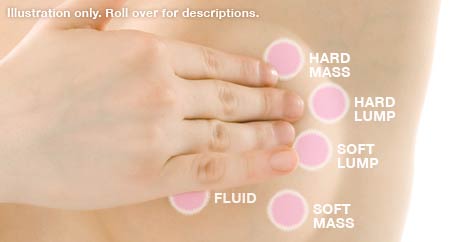What You Must Know if You Find a Lump in Your Breast
July 25, 2008 | By Health Editor

Finding a lump in your breast may leave you in a cold sweat. But here’s a reassuring fact: It usually isn’t cancer. What could it be? We talked with two breast experts at the Cleveland Clinic Taussig Cancer Institute to find out all about breast symptoms and tell you what to do about them. Talk to your doc about any changes in your breasts.
Soft lump
The symptom: A soft, smooth, round lump (like a grape) that moves a little when you press on it and may cause pain when touched; it can be small or large.
Could be: Cysts, or sacs filled with natural fluid.
Caused by: Hormone changes around your period. As many as 30 percent of women between 35 and 50 get them.
What to do: Get an ultrasound to see if the lump is filled with fluid or is solid (and possibly cancerous). Your doctor can insert a needle to drain fluid and relieve pressure if the cyst is painful (although it may come back). Taking the Pill may lower the incidence of cysts.
Fluid
The symptom: Fluid leaking from both nipples.
Could be: Milky discharge.
Caused by: A thyroid or pituitary gland problem, perhaps. Other obvious causes are pregnancy, birth control pills, or nipple stimulation.
What to do: Talk to your doc; if it’s a gland problem, it’s usually treatable with medication.
Soft mass
The symptom: A soft, lumpy mass about 1 to 4 inches wide, accompanied by tenderness in one or both breasts before your period.
Could be: Fibrocystic changes.
Caused by: Fluctuations in estrogen and progesterone, which can thicken breast tissue. The problem affects more than 50 percent of women and often comes and goes until menopause.
What to do: Reduce pain by taking acetaminophen or ibuprofen, or by wearing a supportive bra. Limiting fat and caffeine in your diet may help, too. Talk to your doc if symptoms persist. (Find 5 Ways to Cut Your Breast Cancer Risk.)
Hard mass
The symptom: A hard, solid mass that has irregular or jagged sides, as opposed to smooth edges. It usually won’t move or “give” when you push it.
Could be: Cancerous tumor.
Caused by: Nobody knows for sure. Age and family history are risk factors, and studies show that having two alcoholic drinks per day ups your risks by 10 percent.
What to do: Call your doctor and get a mammogram.
Hard lump
The symptom: A hard, round, clearly defined lump (which could be very small or up to 5 inches wide) that can be moved around under the skin without any pain.
Could be: Fibroadenomas.
Caused by: Changing hormone levels. These benign tumors are not as common as cysts, but they’re not unusual among women in their 20s and 30s.
What to do: Get a mammogram. A biopsy is probably unnecessary, according to the latest research, but check with your doctor. Surgical removal is an option if the tumor is large.
By Jennifer Matlack

No comments:
Post a Comment